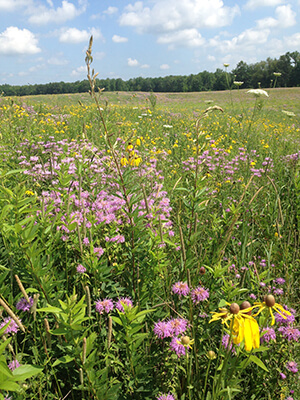
What makes a honey bee colony grow and produce lots of honey? Ask this question to two beekeepers and you’re likely to receive more than two answers. Perhaps dozens.
Intuitively, we all know climate, weather, and land use are important. Multi-year droughts (climate) and month-to-month variability in rainfall (weather) each very clearly influence the availability of floral resources in a given landscape. And phrases like “a given landscape” explain at least some of the reason why your bees at one apiary fill twice as many supers as another apiary that’s five miles down the road; the land around that first apiary simply has better forage. And, of course there are other factors, such as pesticides and parasites such as varroa.
So, what does science have to say about this question? If we focus only on climate, weather, and land use, which is the most important for colony growth and honey production? And do these factors interact? In other words, if our climate changes, can certain types of land use buffer the impact of climate on bees? These are the topics for the fifty-sixth Notes from the Lab, where I summarize “Grassy-herbaceous land moderates regional climate effects on honey bee colonies in the Northcentral US,” written by Gabriela Quinlan and colleagues and published in the journal Environmental Research Letters [2022].
For their study, Quinlan and colleagues made use of an impressive multi-state network of experimental honey bee colonies in the Northcentral U.S. (see Figure 1). In total, the authors monitored 644 colonies at 162 apiary locations in 7 states (Michigan, Minnesota, North Dakota, Ohio, Pennsylvania, South Dakota, and Wisconsin) for 5 years (2015-2019).
Each colony was fitted with a scale that continuously logged colony weight at least every hour throughout the peak summer months (July 1-August 31). Approximately 2.9 million logged colony weights were used to assess weight gain — the main response of interest — during the July 1-August 31 time period.
The authors tested how variation in weight gain among colonies in space and time was influenced by 23 climate, weather, and land use factors. This included eight climate factors (30-yr averages of temperature and precipitation for spring, summer, autumn, and winter at each location), nine weather factors (1-yr averages of temperature and precipitation for each season, plus growing degree days), and six land use factors (proportion of grass crops, woody-herbaceous crops, grassy-herbaceous natural land, woody natural land, and developed land within a 2-km flight radius of the colony).
All 23 factors were evaluated for their ability to explain colony weight gain via something called a random forest model. This type of model can be advantageous for large datasets that assess lots of factors (e.g., the 23 factors in the authors’ analysis) and have other issues that introduce problems for traditional statistical models. Finally, it’s important to note that the 644 colonies enrolled in this study were under a variety of management conditions, but all colonies were managed for varroa and monitored for diseases.
So, what did they find? What were the most important factors explaining colony weight gain? Climate was the most important factor that influenced colony weight gain. Specifically, long-term (i.e., 30-yr) average winter temperature and precipitation were the most important factors, followed by long-term average autumn and spring precipitation. Colonies in wet and warm climates (Wisconsin, Michigan, Ohio, and Pennsylvania) had the lowest weight gain in July and August (see Figure 1) compared to colonies in cool, dry climates (the Dakotas and Minnesota).
What about weather? Was it important? Yes. When summer advanced more quickly (i.e., higher growing degree day accumulation by August 1), colonies gained 2-3 kg less weight in July and August. Interestingly, this is consistent with speculation by several beekeepers about a main cause of year-to-year variation in honey production in upstate New York. Also, in years with warmer preceding autumns, colonies gained 3-4 kg less weight the following summer than in years with cooler preceding autumns.
And how about land use? Were particular types of land use better than others? Yes. The proportion of grassy-herbaceous natural land within a 2-km radius of an apiary positively influenced colony weight gain, while woody natural land negatively influenced ….


